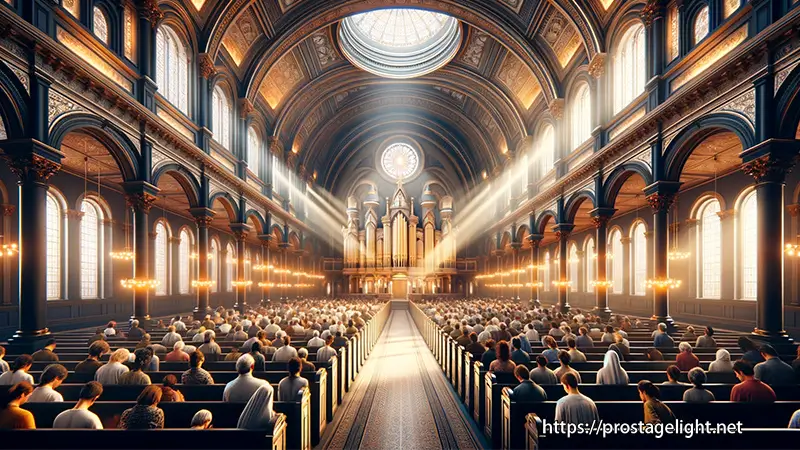
Introduction to Church Lighting
Importance of Lighting in Enhancing the Worship Experience
The purpose of lighting in church spaces goes beyond simply providing illumination; it encompasses creating the right atmosphere, directing focus, and elevating the overall worship experience. Thoughtfully designed lighting can transform a simple space into a sacred, immersive environment. With the right lighting, a church can create an atmosphere that encourages reflection, celebration, and community.
Overview of Recent Trends in Church Lighting Design
Recent trends in church lighting have moved towards more dynamic and flexible systems. Modern churches are adopting lighting designs that can adapt to different types of services and events, from traditional worship to contemporary concerts. The integration of technology, like smart lighting and DMX control systems, allows for precise and varied lighting setups, catering to the specific needs of each moment in the service.

Understanding the Basics of Church Lighting
Types of Lighting Fixtures Commonly Used in Churches
Churches use a range of lighting fixtures to achieve the desired effects:
- Ellipsoidal Lights: Ideal for precise, focused lighting, commonly used to highlight the altar or pulpit.
- Floodlights and Spotlights: Used to illuminate large areas or create dramatic emphasis on specific elements.
- Pendants, Chandeliers, and Suspended Lights: These provide general illumination and are particularly effective in churches with high ceilings.
- Wall Washers: Used to light up walls or architectural features, enhancing the space's aesthetic.
The Role of Natural vs. Artificial Lighting in Church Spaces
The interplay between natural and artificial lighting is crucial in church design. Large windows in traditional churches allow for natural light, which needs to be balanced with artificial lighting to ensure even illumination throughout the day. Artificial lighting is used to complement and enhance natural light, creating a harmonious and inviting atmosphere.

Design Principles for Church Lighting
Balancing Aesthetics and Functionality
Effective church lighting strikes a balance between aesthetics and practicality. It should be visually appealing, highlighting architectural features and artistic elements while also being functional for reading, singing, and safe movement within the space.
Creating a Focus on the Altar or Stage
Lighting should direct attention to the altar or stage, the focal point of worship. Using higher intensity and contrast in these areas helps to draw the congregation's eyes and minds towards the central activities of the service.
Utilizing Color and Intensity to Set the Mood
Colors and intensity play a significant role in setting the mood for different parts of a service. Warmer tones can create a sense of intimacy and reflection, while cooler tones might be used for more energetic or contemplative moments.

Technological Advancements in Church Lighting
The Rise of DMX Control Systems for Flexible Lighting Management
DMX control systems have revolutionized church lighting, allowing for precise control of lighting fixtures. These systems enable easy adjustments of intensity, color, and focus, making it simple to tailor the lighting to different parts of a service or event.
How Smart Lighting Can Enhance Worship Services
By implementing smart lighting systems, it becomes possible to automate alterations in lighting, synchronize it with music, and even control it from a distance. This innovative technology enables the creation of dynamic and responsive lighting environments, ultimately enhancing the worship experience to a great extent.

Practical Tips for Implementing Effective Church Lighting
Key Considerations When Selecting Lighting Fixtures
When selecting lighting fixtures for a church, consider factors like the ceiling height, the color and material of the walls and ceiling, and the types of events the space will host. It's also important to think about energy efficiency and ease of maintenance.
Incorporating Lighting into Different Church Architectural Styles
The lighting design should complement the architectural style of the church. For traditional churches, softer, more diffuse lighting might be appropriate, while contemporary spaces might benefit from bolder, more direct lighting schemes.
Collaborating with Professionals for Custom Lighting Solutions
The Importance of Working with Lighting Design Experts
Professional lighting designers can help create a lighting plan that meets the specific needs and constraints of a church. They bring expertise in the latest technologies and design principles, ensuring a solution that is both beautiful and functional.
Case Studies: Successful Church Lighting Projects
Examining successful church lighting projects can provide valuable insights. For example, Tidal Creek Fellowship Church in South Carolina underwent a transformative lighting upgrade, prioritizing key areas like front wash, backlight, atmospheric lights, and house lights for a complete overhaul of their worship experience.
Conclusion
Recap of Key Points
This guide has explored the importance of lighting in enhancing the worship experience, the basics of church lighting, design principles, technological advancements, practical implementation tips, and the value of professional collaboration.
Encouraging Churches to Explore Innovative Lighting Solutions
Churches are encouraged to explore innovative lighting solutions to enhance their worship spaces. By embracing new technologies and design principles, they can create dynamic, engaging environments that uplift and inspire their congregations.
Frequently Asked Questions
What are the key trends in church lighting for 2024?
The key trends include the use of smart lighting systems, DMX control for flexible lighting management, and a focus on energy-efficient LED technologies.
How does lighting affect the worship experience in a church?
Proper lighting sets the mood, focuses attention, and enhances the overall ambiance, contributing significantly to the worship experience.
What should be considered when choosing lighting fixtures for a church?
Consider the church's architecture, the type of worship services, energy efficiency, and maintenance requirements.
How can technology improve church lighting?
Technology, such as DMX control systems and smart lighting, allows for more dynamic, flexible, and responsive lighting setups, enhancing the worship experience.
Why is it important to balance natural and artificial lighting in churches?
Balancing natural and artificial lighting ensures even illumination, enhances the aesthetic appeal of the space, and creates a welcoming and comfortable environment for worship.
